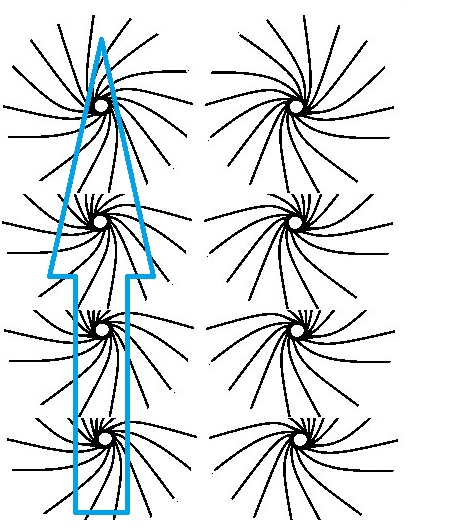What is the cause of the Lorentz Force?
The "screw" nature of electromagnetism. Minkowski referred to it in Space and Time, as did Maxwell in On Physical Lines of Force: "a motion of translation along an axis cannot produce a rotation about that axis unless it meets with some special mechanism, like that of a screw". This is why the right hand rule applies to both electromagnetism and to screw threads. IMHO to really "get" this, you have to take note of Jackson's Classical Electrodynamics: "one should properly speak of the electromagnetic field Fμν rather than E or B separately". Then you need to depict Fμν for an electron. One simplistic way to do it is to combine the radial electric field lines with concentric magnetic field lines like this:

It's simplistic, but now you start to appreciate the electron's "spinor" nature. And if you've taken note of Maxwell's page title, you may appreciate that counter-rotating vortices attract and co-rotating vortices repel. Whilst an electron doesn't involve some fluid motion, there is the Poynting vector and a "circulating energy flow", so the analogy works. As a result if you set down an electron near a positron they will move towards one another in a straight line. But if you throw the electron past the positron they will also move around each other, something like this:

This is what we see in positronium, and now the Lorentz force $\mathbf{F} = q\left[\mathbf{E} + (\mathbf{v} \times \mathbf{B})\right]$ looks obvious. It's just a combination of the linear and rotational force that results from "spinor" electromagnetic field interactions. And it fits with QED in that the electron and positron are "exchanging field". Positronium is like hydrogen but lighter and short-lived, and as you know hydrogen doesn't have much in the way of a field$^*$.
Is it possible to explain what actually causes the force on a current-carrying conductor in a magnetic field?
Yes. You can understand the linear and rotational forces between charged particles easily enough. The next step is to understand the rotational force on a charged particle near a current-carrying conductor. That's essentially a stationary column of metal ions and a moving column of electrons. Ever read Einstein talking about a field as a state of space? OK, see the gravitomagnetic field, which is described as "twisted space" by NASA author Tony Phillips? You can think of the electromagnetic field as something similar but a tad more intense. Only if you had motion relative to it, you might think of it as "turning space" and start talking about curl aka rot which is short for rotor. IMHO this is the key to really understanding how magnets work. The electrons all have a negative electromagnetic field, and the metal ions all have a positive electromagnetic field with the opposite chirality. If the electrons weren't moving, the opposite "twist fields" would just about cancel each other out$^*$. However the electrons are moving up the wire:

So it's like you're moving through one set of twist fields but not the other. And when you have motion relative to a twist field, you think of it as a turn field, and that's what a magnetic field is. So what you "see" is a residual turn field, a magnetic field, around the wire. An electron thrown past the wire moves in a circular fashion not because of some magical action-at-a-distance force, but because it's "a dynamical spinor in frame-dragged space".
The last step is to understand why two wires move together. For this you can think of your electron being confined in the adjacent wire. It moves upwards, and it moves in a circular fashion. This rotation means the residual turn field looks like a twist field, and since the rotations are counter-rotations to the left and right, you're again in a situation where counter-rotating vortices attract. There's a net linear attraction between the two wires. For the catapult, bend one of the wires into a loop to make a primitive solenoid, then into multiple loops for a better solenoid, which is akin to a bar magnet. Then bend it into a horseshoe shape and put the other wire between the poles like this:
 Image courtesy of SPM physics
Image courtesy of SPM physics
Again, it moves.
$*$ There is a residual field, but we don't call it an electric field or a magnetic field. Or an electromagnetic field. Or a gravitomagnetic field.





 Image courtesy of
Image courtesy of